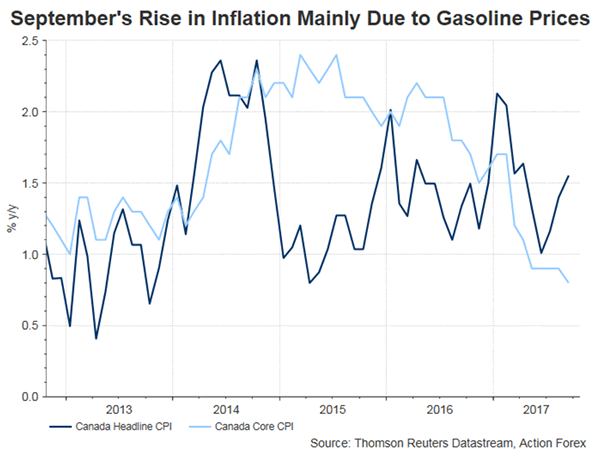Showing genuine concerns over the downside risks to inflation, BOC indicated it would be more ‘cautious’ over future rate hike decisions. In the concluding statement, policymakers stressed that ‘while less monetary policy stimulus will likely be required over time, Governing Council will be cautious in making future adjustments to the policy rate’. The tone in this October appears more dovish than previous ones, likely resulting from recent developments of disappointing progress in NAFTA negotiations, household debt levels and appreciation of Canadian dollar. USDCAD jumped about +1% after the announcement.
After unexpectedly taking the policy rate higher, by +25 bps, to 1% in September, the BOC kept its powder dry this month. During the period, incoming data have sent a mixed note. GDP growth in July was flat from June, ending the 8-month uptrend. Retail sales surprisingly contracted -0.3% m/m in August, following a +0.4% growth in July. Excluding sales at gas stations and auto dealers, retail sales was down -1.3% for the month. On inflation, headline CPI accelerated to +1.6% in September, from +1.4% a month ago. However, if gasoline prices were excluded, inflation climbed +1.1%. Concerning BOC’s preferred measures, trimmed CPI rose to +1.5%, while both median and common CPI stayed unchanged at +1.8% and +1.5% respectively. Canada’s unemployment rate stayed at 9-year low of 6.25 in September while wage growth remained limited.
Against this backdrop, BOC retained the view that domestic economy has operated ‘close to its potential’. However, it remained concerned over the slack in the labour market, given the limited wage growth. The officials upgraded the GDP growth forecasts from 2017 to 2019. The economy is expected to expand +3.1% (previous: +2.8%) this year, before easing to +2.1% (previous: +2%) in 2018 and to +1.5% (previous: +1.6%) in 2019. Inflation forecast for 2018 is adjusted slightly lower to +1.7%, from +1.8% previously, while that for 2019 stayed unchanged at +2.1%. The central bank anticipates inflation to reach the +2% target by the second half of next year.
At the press conference, governor Poloz dismissed concerns over overshooting of inflation. Rather he suggested that ‘given our recent history with inflation running below target, we continue to be more preoccupied with the downside risks to inflation’. The accompanying statement also reminded that the remaining slack in labour markets suggested that there is ‘room for more economic growth than the Bank is projecting without inflation rising materially above target’.
Notwithstanding the fact that the loonie has dropped about -6% against US dollar from its high made on September 8, BOC warned of the strength in the exchange rate. This indicates the central bank’s worry over the currency’s impact on inflation and exports growth. Indeed, it noted the reason for it to push backward the time for inflation to reach the +2% target is ‘recent strength in the Canadian dollar’. Meanwhile, it also warned that ‘projected export growth is slightly slower than before, in part because of a stronger Canadian dollar than assumed in July’.
In the concluding statement, BOC pledged to stay ‘cautious’ in making future monetary decision, reinforcing that it would be ‘guided by incoming data to assess the sensitivity of the economy to interest rates, the evolution of economic capacity, and the dynamics of both wage growth and inflation’.















